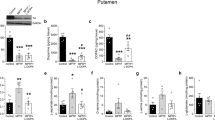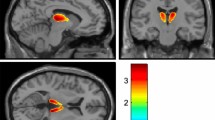Abstract
WHEN L-3,4-dihydroxyphenylalanine (L-dopa) is administered to human subjects1, the greater proportion is metabolised by decarboxylation, a small amount by O-methylation and traces only by transamination2. It seems likely that the benefit resulting from L-dopa therapy in Parkinsonian patients derives largely from the generation of one of its metabolites, dopamine, by decarboxylation within the central nervous system3. Less than 5% of administered L-dopa becomes available for this purpose: most of the dose is decarboxylated peripherally4. There is good reason to believe that the dopamine so formed is unable to penetrate the blood-brain barrier to any great extent5, so that little of the original dose is available to contribute to the therapeutic response. By blocking peripheral decarboxylase, however, certain decarboxylase inhibitors6,7, which are themselves unable to cross the blood-brain barrier to any significant extent8, bring about an accumulation in the plasma of administered L-dopa, thus providing a higher concentration gradient to enter the central nervous system and allowing lower oral doses of L-dopa to be employed therapeutically9.
This is a preview of subscription content, access via your institution
Access options
Subscribe to this journal
Receive 51 print issues and online access
$199.00 per year
only $3.90 per issue
Buy this article
- Purchase on Springer Link
- Instant access to full article PDF
Prices may be subject to local taxes which are calculated during checkout
Similar content being viewed by others
References
Brogden, R. N., Speight, T. M., and Avery, G. S., Drugs, 2, 262 (1971).
Sandler, M., in Handbook of Experimental Pharmacology (Catecholamines) (edit. by Blaschko, H., and Muscholl, E.), 33, 845 (Springer, Berlin, 1972).
Hornykiewicz, O., Br. med. Bull., 29, 172 (1973).
Bianchine, J. R., Messiha, F. S., and Preziosi, T. J., Adv. Neurol., 2, 101 (1973).
Weil-Malherbe, H., Axelrod, J., and Tomchick, R., Science, N.Y., 129, 1226 (1959).
Burkard, W. P., Gey, K. F., and Pletscher, A., Experientia, 18, 411 (1962).
Porter, C. C., Watson, L. S., Titus, D. C., Totaro, J. A., and Byer, S. S., Biochem. Pharmac., 11, 1067 (1962).
Barthiolini, G., and Pletscher, A., J. Pharmac. exp. Ther., 161, 14 (1968).
Birkmayer, W., Wien. klin. Wschr., 81, 677 (1969).
Messiha, F. S., Hsu, T. H., and Bianchine, J. R., J. clin. Invest., 51, 452 (1972).
Calne, D. B., Reid, J. L., Vakil, S. D., Rao, S., Petrie, A., Pallis, C. A., Gawler, J., Thomas, P. K., and Hilson, A., Br. med. J., 3, 729 (1971).
Calne, D. B., Karoum, F., Ruthven, C. R. J., and Sandler, M., Br. J. Pharmac. Chemother., 37, 57 (1969).
Karoum, F., Ruthven, C. R. J., and Sandler, M., clin. chim. Acta, 20, 427 (1968).
Karoum, F., Ruthven, C. R. J., and Sandler, M., Biochem. Med., 5, 505 (1971).
Messiha, F. S., Hsu, T. H., and Bianchine, J. R., Biochem. Pharmac., 21, 2144 (1972).
Muenter, M. D., Dinapoli, R. P., Sharpless, N. S., and Tyce, G. M., Mayo clin. Proc., 48, 173 (1973).
Zannoni, V. G., and Weber, W. W., J. biol. Chem., 241, 1340 (1966).
Weber, W. W., and Zannoni, V. G., J. biol. Chem., 241, 1345 (1966).
Sandler, M., Bonham Carter, S., Hunter, K. R., and Stern, G. M., Nature, 241, 439 (1973).
Fellman, J. H., Fujita, T. S., and Roth, E. S., Biochim. biophys. Acta, 268, 601 (1972).
Thoenen, H., in Handbook of Experimental Pharmacology (Catecholamines) (edit. by Blaschko, H., and Muscholl, E.), 33, 813 (Springer, Berlin, 1972).
Author information
Authors and Affiliations
Rights and permissions
About this article
Cite this article
SANDLER, M., JOHNSON, R., RUTHVEN, C. et al. Transamination is a Major Pathway of L-Dopa Metabolism following Peripheral Decarboxylase Inhibition. Nature 247, 364–366 (1974). https://doi.org/10.1038/247364b0
Received:
Issue Date:
DOI: https://doi.org/10.1038/247364b0
Comments
By submitting a comment you agree to abide by our Terms and Community Guidelines. If you find something abusive or that does not comply with our terms or guidelines please flag it as inappropriate.



